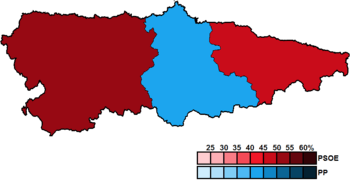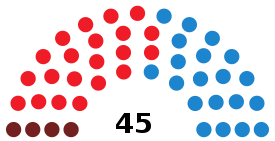2007 Asturian regional election
The 2007 Asturian regional election was held on Sunday, 27 May 2007, to elect the 7th General Junta of the Principality of Asturias. All 45 seats in the General Junta were up for election. The election was held simultaneously with regional elections in twelve other autonomous communities and local elections all throughout Spain.
| |||||||||||||||||||||||||||||||||||||||||||||
All 45 seats in the General Junta of the Principality of Asturias 23 seats needed for a majority | |||||||||||||||||||||||||||||||||||||||||||||
|---|---|---|---|---|---|---|---|---|---|---|---|---|---|---|---|---|---|---|---|---|---|---|---|---|---|---|---|---|---|---|---|---|---|---|---|---|---|---|---|---|---|---|---|---|---|
| Opinion polls | |||||||||||||||||||||||||||||||||||||||||||||
| Registered | 981,802 | ||||||||||||||||||||||||||||||||||||||||||||
| Turnout | 604,682 (61.6%) | ||||||||||||||||||||||||||||||||||||||||||||
| |||||||||||||||||||||||||||||||||||||||||||||
 Constituency results map for the General Junta of the Principality of Asturias | |||||||||||||||||||||||||||||||||||||||||||||
| |||||||||||||||||||||||||||||||||||||||||||||
Overview
Electoral system
The General Junta of the Principality of Asturias was the devolved, unicameral legislature of the autonomous community of Asturias, having legislative power in regional matters as defined by the Spanish Constitution and the Asturian Statute of Autonomy, as well as the ability to vote confidence in or withdraw it from a President of the Principality.[1] Voting for the General Junta was on the basis of universal suffrage, which comprised all nationals over eighteen, registered in Asturias and in full enjoyment of their political rights.
The 45 members of the General Junta of the Principality of Asturias were elected using the D'Hondt method and a closed list proportional representation, with a threshold of 3 percent of valid votes—which included blank ballots—being applied in each constituency. Parties not reaching the threshold were not taken into consideration for seat distribution. Additionally, the use of the D'Hondt method might result in an effective threshold over three percent, depending on the district magnitude.[2] Seats were allocated to constituencies, which were established by law as follows:
- Central District (comprising the municipalities of Aller, Avilés, Bimenes, Carreño, Caso, Castrillón, Corvera de Asturias, Gijón, Gozón, Illas, Las Regueras, Langreo, Laviana, Lena, Llanera, Mieres, Morcín, Noreña, Oviedo, Proaza, Quirós, Ribera de Arriba, Riosa, San Martín del Rey Aurelio, Santo Adriano, Sariego, Siero, Sobrescobio and Soto del Barco).
- Eastern District (comprising the municipalities of Amieva, Cabrales, Cabranes, Cangas de Onís, Caravia, Colunga, Llanes, Nava, Onís, Parres, Peñamellera Alta, Peñamellera Baja, Piloña, Ponga, Ribadedeva, Ribadesella and Villaviciosa).
- Western District (comprising the municipalities of Allande, Belmonte de Miranda, Boal, Candamo, Cangas del Narcea, Castropol, Coaña, Cudillero, Degaña, El Franco, Grado, Grandas de Salime, Ibias, Illano, Muros de Nalón, Navia, Pesoz, Pravia, Salas, San Martín de Oscos, Santa Eulalia de Oscos, San Tirso de Abres, Somiedo, Tapia de Casariego, Taramundi, Teverga, Tineo, Valdés, Vegadeo, Villanueva de Oscos, Villayón and Yernes y Tameza).
Each constituency was entitled to an initial minimum of two seats, with the remaining 39 allocated among the constituencies in proportion to their populations.[3]
The electoral law provided that parties, federations, coalitions and groupings of electors were allowed to present lists of candidates. However, groupings of electors were required to secure the signature of at least 1 percent of the electors registered in the constituency for which they sought election. Electors were barred from signing for more than one list of candidates. Concurrently, parties and federations intending to enter in coalition to take part jointly at an election were required to inform the relevant Electoral Commission within ten days of the election being called.[3][4][5]
Election date
The term of the General Junta of the Principality of Asturias expired four years after the date of its previous election. Elections to the General Junta were fixed for the fourth Sunday of May every four years. The previous election was held on 25 May 2003, setting the election date for the General Junta on Sunday, 27 May 2007.[1][3][4][5]
The President of the Principality had the prerogative to dissolve the General Junta and call a snap election, provided that no motion of no confidence was in process, no nationwide election was due and some time requirements were met: namely, that dissolution did not occur either during the first legislative session or within the legislature's last year ahead of its scheduled expiry, nor before one year had elapsed since a previous dissolution under this procedure. In the event of an investiture process failing to elect a regional President within a two-month period from the first ballot, the General Junta was to be automatically dissolved and a fresh election called. Any snap election held as a result of these circumstances would not alter the period to the next ordinary election, with elected deputies merely serving out what remained of their four-year terms.[1]
Opinion polls
The table below lists voting intention estimates in reverse chronological order, showing the most recent first and using the dates when the survey fieldwork was done, as opposed to the date of publication. Where the fieldwork dates are unknown, the date of publication is given instead. The highest percentage figure in each polling survey is displayed with its background shaded in the leading party's colour. If a tie ensues, this is applied to the figures with the highest percentages. The "Lead" column on the right shows the percentage-point difference between the parties with the highest percentages in a given poll. When available, seat projections are also displayed below the voting estimates in a smaller font. 23 seats were required for an absolute majority in the General Junta of the Principality of Asturias.
- Color key:
Exit poll
| Polling firm/Commissioner | Fieldwork date | Sample size | Turnout | URAS PAS |
Lead | |||
|---|---|---|---|---|---|---|---|---|
| 2007 regional election | 27 May 2007 | N/A | 61.6 | 42.0 21 |
41.5 20 |
9.7 4 |
2.2 0 |
0.5 |
| Ipsos/RTVE–FORTA[p 1][p 2] | 27 May 2007 | ? | ? | 44.1 21/24 |
37.2 18/20 |
11.1 4/5 |
– | 6.9 |
| Celeste-Tel/Terra[p 3][p 4] | 9–15 May 2007 | ? | ? | 39.7 20 |
37.8 19 |
13.5 6 |
– | 1.9 |
| InvesMark/El Comercio[p 5] | 4–14 May 2007 | 1,600 | 61.2 | 40.2 19/21 |
41.2 20/21 |
10.8 4 |
3.2 0/1 |
1.0 |
| Sigma Dos/El Mundo[p 6][p 7] | 27 Apr–8 May 2007 | 600 | ? | 40.2 18/20 |
43.5 21/23 |
11.1 4 |
– | 3.3 |
| CIS[p 8][p 9] | 9 Apr–6 May 2007 | 1,197 | ? | 40.2 21 |
36.0 19 |
13.2 5 |
– | 4.2 |
| Noxa/IU[p 10][p 11] | 22 Mar 2007 | ? | ? | 38.9 20 |
38.8 19 |
15.7 6 |
– | 0.1 |
| Sigma Dos/El Mundo[p 12][p 13][p 14] | 16–24 Nov 2006 | ? | ? | 41.0 19/21 |
42.9 20/22 |
11.1 4 |
– | 1.9 |
| 2004 EP election | 13 Jun 2004 | N/A | 44.9 | 46.4 | 44.4 | 6.3 | 0.5 | 2.0 |
| 2004 general election | 14 Mar 2004 | N/A | 71.7 | 43.4 | 43.8 | 8.4 | 0.6 | 0.4 |
| 2003 regional election | 25 May 2003 | N/A | 63.8 | 40.5 22 |
39.2 19 |
11.0 4 |
4.7 0 |
1.3 |
Results
Overall
 | ||||||
| Parties and coalitions | Popular vote | Seats | ||||
|---|---|---|---|---|---|---|
| Votes | % | ±pp | Total | +/− | ||
| Spanish Socialist Workers' Party (PSOE) | 252,201 | 42.04 | +1.56 | 21 | –1 | |
| People's Party (PP) | 248,907 | 41.50 | +2.32 | 20 | +1 | |
| United Left–Bloc for Asturias–The Greens of Asturias (IU–BA–LV)1 | 58,114 | 9.69 | –2.42 | 4 | ±0 | |
| Asturian Renewal Union–Asturianist Party (URAS–PAS)2 | 13,314 | 2.22 | –2.46 | 0 | ±0 | |
| Unity (Unidá) | 4,119 | 0.69 | New | 0 | ±0 | |
| Andecha Astur (AA) | 2,770 | 0.46 | –0.16 | 0 | ±0 | |
| Communist Party of the Peoples of Spain (PCPE) | 2,001 | 0.33 | +0.13 | 0 | ±0 | |
| Republican Left (IR) | 1,707 | 0.28 | New | 0 | ±0 | |
| National Democracy (DN) | 884 | 0.15 | New | 0 | ±0 | |
| Asturian Council (Conceyu) | 782 | 0.13 | +0.05 | 0 | ±0 | |
| Asturian Democratic Convergence (CDAS) | 581 | 0.10 | +0.04 | 0 | ±0 | |
| Blank ballots | 14,458 | 2.41 | +0.12 | |||
| Total | 599,838 | 45 | ±0 | |||
| Valid votes | 599,838 | 99.20 | –0.09 | |||
| Invalid votes | 4,844 | 0.80 | +0.09 | |||
| Votes cast / turnout | 604,682 | 61.59 | –2.25 | |||
| Abstentions | 377,120 | 38.41 | +2.25 | |||
| Registered voters | 981,802 | |||||
| Sources[6][7][8][9] | ||||||
Aftermath
| Investiture | |||||
| Ballot → | 6 July 2007 | 9 July 2007 | |||
|---|---|---|---|---|---|
| Required majority → | 23 out of 45 | Simple | |||
|
21 / 45 |
21 / 45 |
|||
23 / 45 |
23 / 45 | ||||
Absentees
|
1 / 45 |
1 / 45 | |||
| Sources[9][10] | |||||
References
- Opinion poll sources
- "PP y PSOE mantienen sus comunidades autónomas y podría haber cambios en Navarra y Baleares". Libertad Digital (in Spanish). 27 May 2007.
- "Sólo Navarra y Baleares podrían cambiar de gobierno, según el sondeo de RTVE y FORTA". Europa Press (in Spanish). 27 May 2007.
- "Vuelco electoral en Navarra, Baleares y Canarias y aplastante victoria del PP en Madrid". Terra (in Spanish). 17 May 2007. Archived from the original on 20 May 2007.
- "Encuestas autonómicas". Celeste-Tel (in Spanish). 17 May 2007. Archived from the original on 11 May 2009.
- "El PP será el partido más votado en asturias pero PSOE e IU podrán gobernar en coalición". El Comercio (in Spanish). 20 May 2007.
- "Sondeo de Sigma Dos: El PSOE mantendría sus comunidades si revalida las coaliciones". El Mundo (in Spanish). 13 May 2007.
- "Elecciones 27-M / Sondeo El Mundo-Sigma Dos". El Mundo (in Spanish). 12 May 2007.
- "Preelectoral elecciones autonómicas, 2007. CA del Principado de Asturias (Estudio nº 2688. Abril-Mayo 2007)" (PDF). CIS (in Spanish). 11 May 2007.
- "La aritmética juega en contra del PSOE sólo en las islas Canarias". La Vanguardia (in Spanish). 12 May 2007.
- "Un sondeo de IU augura un empate de PSOE y PP y eleva las expectativas de la coalición a 6 escaños". La Nueva España (in Spanish). 23 March 2007. Archived from the original on 4 May 2007.
- "La izquierda admite la probable victoria del PP en Asturias y ya prevé un bipartito "a la gallega"". El Dorado (in Spanish). 23 March 2007. Archived from the original on 4 July 2018.
- "El PP y el PSOE mantendrán sus gobiernos autonómicos, aunque los socialistas bajan". El Mundo (in Spanish). 27 November 2006.
- "Varapalo al PSOE, pero podrá gobernar". El Mundo (in Spanish). 27 November 2006. Archived from the original on 16 November 2011.
- "El voto en las comunidades. Elecciones autonómicas 2007" (PDF). El Mundo (in Spanish). 27 November 2006.
- Other
- "Statute of Autonomy for Asturias of 1981". Organic Law No. 7 of 30 December 1981. Official State Gazette (in Spanish). Retrieved 14 March 2017.
- Gallagher, Michael (30 July 2012). "Effective threshold in electoral systems". Trinity College, Dublin. Archived from the original on 30 July 2017. Retrieved 22 July 2017.
- "General Junta of the Principality of Asturias Elections System Law of 1986". Law No. 14 of 26 December 1986. Official Gazette of the Principality of Asturias (in Spanish). Retrieved 14 March 2017.
- "General Electoral System Organic Law of 1985". Organic Law No. 5 of 19 June 1985. Official State Gazette (in Spanish). Retrieved 28 December 2016.
- "Representation of the people Institutional Act". www.juntaelectoralcentral.es. Central Electoral Commission. Retrieved 16 June 2017.
- "General Junta of the Principality of Asturias election results, 27 May 2007" (PDF). www.juntaelectoralcentral.es (in Spanish). Electoral Commission of Asturias. 14 June 2007. Retrieved 8 December 2019.
- "Electoral Results. General Junta of the Principality of Asturias. 7th Legislature (2007–2011)". www.jgpa.es (in Spanish). General Junta of the Principality of Asturias. Retrieved 29 November 2019.
- "Electoral Results. 2007". www.sadei.es (in Spanish). SADEI. Retrieved 27 September 2017.
- "General Junta of the Principality of Asturias elections since 1983". historiaelectoral.com (in Spanish). Electoral History. Retrieved 27 September 2017.
- "Areces gobernará Asturias en minoría tras ser reelegido sin el apoyo de IU". El País (in Spanish). 10 July 2007. Retrieved 8 December 2019.
.jpg)

.jpg)